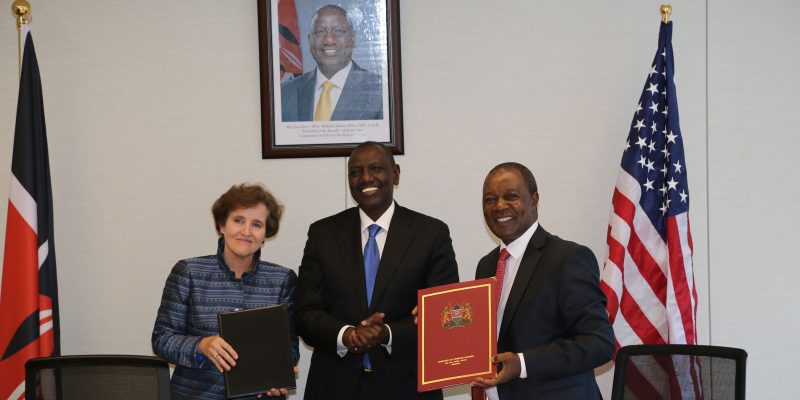
MCC CEO Alice Albright, President of Kenya William S. Ruto, and Njuguna Ndung’u, Cabinet Secretary, National Treasury and Economic Planning of Kenya, upon the signing of the threshold program agreement between MCC and the Government of Kenya.
The Kenya Urban Mobility and Growth Threshold Program seeks to assist Kenya in addressing limited connectivity in urban areas, a critical constraint to economic growth. Analysis, conducted jointly by MCC and the Government of Kenya, revealed that Kenya’s urban areas—particularly in the capital city, Nairobi—did not enjoy the significant productivity gains frequently associated with urbanization. Limited planning and a lack of prioritization in investments related to land use and transportation undermine connectivity and lead to fragmentation, limiting productivity among manufacturing firms in Nairobi and between workers and economic opportunities.
The threshold program will address this constraint through four projects: the Integrated Transport Planning Project, the First and Last Mile Connections Project, the Detailed Land Use Project, and the Blended Finance for Bus Rapid Transit (BRT) Project.
Financials
Financials as of June 30, 2024
Program Budget
Milestones
-
Signed:
September 19, 2023 -
Entry Into Force:
May 23, 2024
Program Projects
-
$12,000,000
Project Total Amount -
$0
Project Amount Committed -
$0
Project Amount Expended
The Blended Finance for BRT Project aims to catalyze private financing required for the operationalization of Nairobi’s BRT system. The project aims to contribute to the Government of Kenya’s urban transportation goals.
-
$13,900,000
Project Total Amount -
$0
Project Amount Committed -
$0
Project Amount Committed
The Detailed Land Use Planning Project aims to modernize the land use planning framework to improve the quality of investments in land in the Nairobi metropolitan area. The four, closely related activities that comprise the project will help the Nairobi City County Government in:
- updating the policy and regulatory framework for detailed land use planning and the control of development within Nairobi City County;
- building capacity for the use of geographic information systems (GIS) in land use planning;
- developing detailed, integrated land use plans within a specified area of eastern Nairobi City County that incorporate stakeholder engagement and introduce concepts of transport-oriented development;
- resolving obstacles and freeing up land for residential, commercial, and industrial investment.
-
$20,000,000
Project Total Amount -
$0
Project Amount Committed -
$0
Project Amount Expended
The First and Last Mile Connections Project is designed to improve access to transportation options within a specified area in the eastern portion of Nairobi City County. The three activities within this project will support the Nairobi City County Government in:
- building internal capacity for planning and prioritizing projects that promote connections between various modes of transport;
- planning, prioritizing, designing, and constructing pedestrian pathways, crosswalks, overpasses, bicycle lanes and pick-up and drop-off points for private bus (matatu) services that facilitate access to stations on the emerging commuter rail network;
- address pervasive problems of sexual harassment on private bus (matatu) services, one of the chief impediments to the mobility of women in urban areas.
-
$6,000,000
Project Total Amount -
$0
Project Amount Committed -
$0
Project Amount Expended
The Integrated Transport Planning Project aims to strengthen the ability of the Nairobi Metropolitan Area Transport Authority (NAMATA) to develop and implement a unified, long-term transport planning process for the Nairobi metropolitan area and to prioritize investments based on access, mobility, and connectivity. The three activities within this project will support NAMATA in:
- developing internal capacities, including the ability to attract and retain human resources, develop technical skills, and communicate results;
- leading the development of a new integrated mobility plan for the Nairobi metropolitan area through public engagement, collection and analysis of data, and coordination with private and public transport service providers;
- improving the division of responsibilities, sharing of information, and governance within the transport sector.


